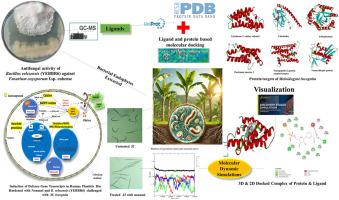Exploring nonanol from Bacillus velezensis (YEBBR6) for root-knot nematode management in bananas: Integrating experimental and computational approaches
IF 2.8
3区 农林科学
Q2 PLANT SCIENCES
引用次数: 0
Abstract
Nematode infestations pose a severe threat to global banana production, leading to substantial yield losses and economic damage. Among these, the root-knot nematode Meloidogyne incognita is particularly detrimental, causing root galls that severely impair water and nutrient uptake, leading to stunted growth, reduced fruit quality, and significant economic losses for farmers. In the face of increasing agricultural challenges, bacterial endophytes have emerged as essential tools for sustainable agriculture, offering ecofriendly solutions to enhance plant health and manage pests. The present study aims to identify and characterise biomolecules from bacterial endophyte Bacillus velezensis (YEBBR6) with potential nematicidal properties against root-knot nematode Meloidogyne incognita infecting banana. The analysis of volatile and non-volatile organic compounds (VOCs/NVOCs) from the inhibition zone during the ditrophic interaction between B. velezensis (YEBBR6) and Fusarium oxysporum f.sp. cubense (Foc) revealed the presence of several distinctive biomolecules with antifungal and antimicrobial properties. These compounds included linoelaedic acid, nonanol, acetylvaleryl, 5–hydroxyl methyl furfural, clindamycin, allobarbital, 3-thiazolidine carboxamide, azulene, aminomorpholine, procyclidine, campholic acid, 3 amino-4 hydroxy phenyl sulfone, 3–deoxy mannoic lactone, hexadecanoic acid, oleic acid, and dihydroacridine. The in-silico analysis revealed that nonanol, exhibited strong binding efficacy against M. incognita protein targets, including cytochrome C oxidase subunit 1, calreticulin, neuropeptide G-protein coupled receptor, chorismate mutase 1, venom allergen-like proteins, and β-1,4-endoglucanase. Notably, nonanol proved more effective than the commercially used nematicide carbofuran 3G. Molecular dynamics studies further supported the potential of nonanol, and its nematicidal properties were validated through in vitro and pot culture studies. Moreover, nonanol was found to induce the expression of defense-related genes, such as MAPK10, WRKY22, ascorbate peroxidase, catalase, and NADPH oxidase, in banana seedlings, thus enhancing the plant's immune response. These findings highlight the potential of nonanol, derived from B. velezensis (YEBBR6), as a potent and environmentally friendly alternative for controlling nematode infestations in banana cultivation.

探索来自 Velezensis 杆菌(YEBBR6)的壬醇在香蕉根结线虫管理中的应用:实验与计算方法的结合
线虫对全球香蕉生产构成严重威胁,导致大量减产和经济损失。其中,根结线虫(Meloidogyne incognita)的危害尤为严重,它造成的根瘿严重影响水分和养分的吸收,导致生长迟缓、果实质量下降,并给农民造成重大经济损失。面对日益严峻的农业挑战,细菌内生菌已成为可持续农业的重要工具,为提高植物健康和管理害虫提供了生态友好的解决方案。本研究旨在从细菌内生菌 Bacillus velezensis (YEBBR6) 中鉴定和描述具有潜在杀线虫特性的生物大分子,以对抗感染香蕉的根结线虫 Meloidogyne incognita。在 B. velezensis (YEBBR6) 与 Fusarium oxysporum f.sp. cubense (Foc) 的二营养作用过程中,对抑制区的挥发性和非挥发性有机化合物(VOCs/NVOCs)进行了分析,发现其中存在几种具有抗真菌和抗微生物特性的独特生物大分子。这些化合物包括亚麻酸、壬醇、乙酰戊酰、5-羟基甲基糠醛、克林霉素、阿洛巴比妥、3-噻唑烷甲酰胺、氮杂环烯、氨基吗啉、原环苷、樟脑酚酸、3-氨基-4-羟基苯砜、3-脱氧甘露内酯、十六烷酸、油酸和二氢吖啶。室内分析表明,壬醇对 M. incognita 蛋白靶标具有很强的结合效力,这些靶标包括细胞色素 C 氧化酶亚基 1、钙网素、神经肽 G 蛋白偶联受体、络氨酸突变酶 1、毒液过敏原样蛋白和 β-1,4-内切葡聚糖酶。值得注意的是,壬醇比市面上使用的杀线虫剂呋喃丹 3G 更有效。分子动力学研究进一步证实了壬醇的潜力,体外和盆栽培养研究也验证了壬醇的杀线虫特性。此外,研究还发现壬醇能诱导香蕉幼苗中与防御相关基因的表达,如 MAPK10、WRKY22、抗坏血酸过氧化物酶、过氧化氢酶和 NADPH 氧化酶,从而增强植物的免疫反应。这些发现凸显了从 B. velezensis(YEBBR6)中提取的壬醇作为控制香蕉种植中线虫侵扰的一种有效且环保的替代品的潜力。
本文章由计算机程序翻译,如有差异,请以英文原文为准。
求助全文
约1分钟内获得全文
求助全文
来源期刊
CiteScore
4.30
自引率
7.40%
发文量
130
审稿时长
38 days
期刊介绍:
Physiological and Molecular Plant Pathology provides an International forum for original research papers, reviews, and commentaries on all aspects of the molecular biology, biochemistry, physiology, histology and cytology, genetics and evolution of plant-microbe interactions.
Papers on all kinds of infective pathogen, including viruses, prokaryotes, fungi, and nematodes, as well as mutualistic organisms such as Rhizobium and mycorrhyzal fungi, are acceptable as long as they have a bearing on the interaction between pathogen and plant.

 求助内容:
求助内容: 应助结果提醒方式:
应助结果提醒方式:


